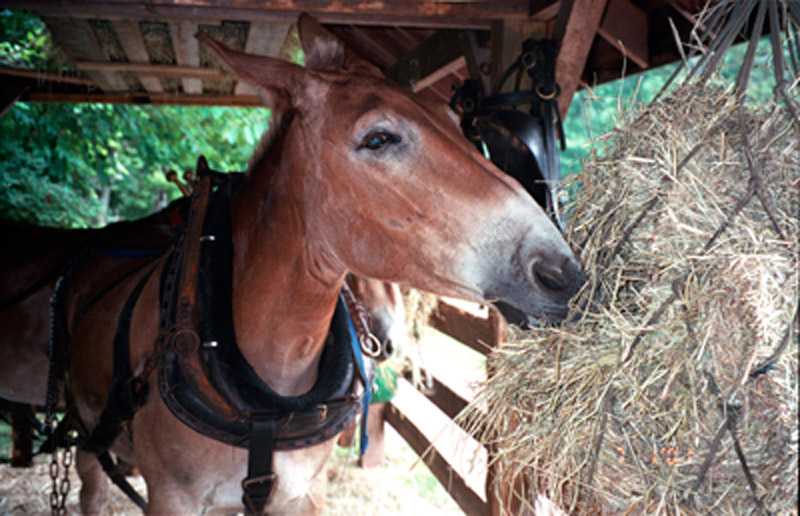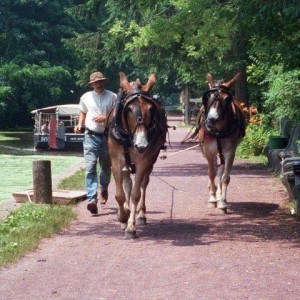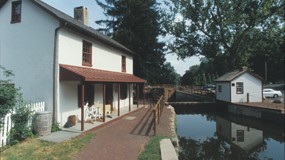Learn About Canal Mules

The following is paraphrased from The Mule, a book by British author Lorraine Travis.
And just what is a mule, anyway?
A mule is a cross between two species of equine: the horse or pony (Equus caballus) and the domestic donkey (Equus asinus). The word “mule” is used for either the cross of male donkey-female horse, or female donkey-male horse. The latter cross is more correctly known as a “hinny.”
Though both mules and hinnies each have one horse and one donkey parent, the two crosses generally differ from each other in appearance and stature. To some extent, the temperament also differs, a fact that has been recognized since they were first bred.
What do mules look like?
The mule has the body of a horse with the extremities of a donkey. The most noticeable points are:
- Long ears
- Short, thin mane, which may stand upright like a donkey’s, or be a little longer and flop over
- A tail with shortish hairs on the dock, a little longer than the donkey’s, but also with long hairs like the horse’s, and much fuller than the donkey’s.
Other common physical characteristics of mules:
- Low or non-existent withers
- Flat back with a “goose rump”
- Flat-sided body with weaker quarters than a horse, also narrower and less deep-shouldered
- Straight legs, like a donkey’s, with small, hard, dense, upright, straight-sided hooves
- Head a little narrower than a donkey’s, but otherwise very similar, except for the eyes; these are specifically mule, but difficult to describe
Advantages
Mules can grow taller than both parents. Weight for weight, they are stronger than horses, and much longer-lived with much longer working lives, although maturing slightly later. Other advantages:
- Rarely become ill or lame, or suffer wounds
- Withstand temperature extremes
- Can live on frugal rations
- Tremendous stamina and resilience
- Exceptionally sure-footed.

Temperament
Mules have a reputation for being obstinate and bad-tempered, but as with donkeys, the mule’s legendary stubbornness is really a manifestation of its talent for self-preservation. There are times when a human finds this “talent” annoying, when he is disobeyed by a mule. However, there are many times when it can be a great advantage: If a mule takes care of itself, then it follows that it is also taking great care of its cargo, human or otherwise. This is a big reason that mules are chosen, rather than horses, to pack tourists down into the Grand Canyon. Intelligent handlers can foresee occasions when a mule is likely to be “stubborn,” and can avoid them.
Intelligence
Mules are highly intelligent and very quick to learn. This means their handlers need to be quick-witted, to stay one jump ahead of them. A well-trained and handled mule is obliging, kind, patient, persevering, calm, tolerant, sensible, loyal, affectionate and playful. They’re also proud, jealous and calculating. This means a badly trained and handled mule can be a problem.
MULE FAQ
How big do mules grow?
Anything from about 32″ to more than 18 hands, depending on the size of the parents.
Do mules come in male and female, and can they have foals?
They have all the normal sexual characteristics, both physical and temperamental. Males are always infertile, and females normally so; fertile mules are very rare. However, males should be castrated to keep them from becoming aggressive.
What can you use mules for?
Anything you can use horses and ponies for, depending only on size:
- Riding
- Racing
- Endurance riding
- Hunting
- Jumping
- Dressage
- Shepherding
- In harness
- Light and heavy hauling
- Agricultural work
- Under pack, for work or leisure.
Are mules really bad-tempered and do they kick?
Mules are only bad-tempered if handled incorrectly and with lack of understanding. They can kick with great speed and accuracy, but only do so in self-defense, when they are afraid or think something is going to hurt them.
Are mules difficult to look after?
They are very easy to look after:
- Rarely ill or lame
- Rarely need shoeing
- Not fussy eaters
- Can withstand extremes of climate.
Are mules difficult to train?
No, but their natures are different than horses’. You must gain your mule’s trust and learn to understand each other, and then he will do anything for you.

